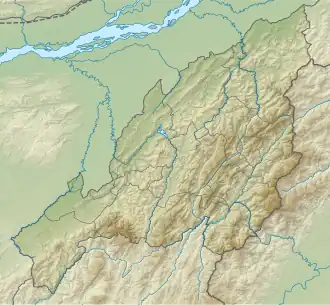Singphan Wildlife Sanctuary
| Singphan Wildlife Sanctuary | |
|---|---|
IUCN category IV (habitat/species management area) | |
 Location in Nagaland, India | |
| Location | Mon district, Nagaland, India |
| Coordinates | 26°55′30″N 94°53′40″E / 26.925°N 94.894306°E |
| Area | 23.57 km2 (9.10 sq mi) |
| Established | 2009 |
| Governing body | Nagaland Forest Department |
Singphan Wildlife Sanctuary is a wildlife sanctuary in the Mon district in the Indian state of Nagaland.[1] The sanctuary covers an area of approximately 23.57 km² (2,357 hectares) and was notified as a wildlife sanctuary in 2009. The area lies along the border with Assam and forms part of a contiguous forest tract important for elephant movement in the region. [2][3] In 2018, it was declared as an elephant reserve.[4]
Wildlife and Habitat
The sanctuary has a tropical wet evergreen and moist deciduous forest types, with bamboo brakes and secondary forests reported in the protected area. It hosts over 180 plant species. Faunal reports and state documentation indicate presence of Asian elephant (Elephas maximus), Jackals etc; the sanctuary is part of a landscape that facilitates seasonal movement of elephants between Nagaland and adjacent Assam reserve forests.[5][6][7]
Conservation & Management
The sanctuary is administered by the Nagaland Forest Department. As part of elephant conservation planning under Project Elephant, the State Government (with central approval) notified the area as the Singphan Elephant Reserve in 2018. Management activities focus on habitat protection, monitoring of elephant movement and community engagement in fringe villages. [8][9]
Threats
Documented threats to the sanctuary and surrounding landscape include habitat disturbance from local resource use, road networks that increase access and edge effects, tree felling, grazing pressure in fringe areas, and potential land-use change in adjoining reserve forests. Research in the sanctuary has highlighted disturbance impacts on forest community structure and regeneration. Conservation management emphasises reducing anthropogenic pressure, improving habitat connectivity, and mitigation of human–elephant conflict in adjacent communities.[5][10]
See also
References
- ^ "Dimapur Wildlife Division observes WED at Singphan Wildlife Sanctuary". www.easternmirrornagaland.com. Retrieved 2025-08-09.
- ^ "About Us - Forest Department Nagaland". Nagaland Forest Department. Retrieved 9 August 2025.
- ^ Pangging, Govinda; Ao, Aosanen; Das, Anup Kumar (2015). "Plant diversity and community characteristics in different disturbance regime in Singphan Wildlife Sanctuary, Nagaland, India". International Journal of Current Research. 7 (11): 22955–22958. Retrieved 9 August 2025.
- ^ NEWS, NE NOW (2018-08-31). "Nagaland govt declares Singphan Wildlife Sanctuary as Singphan Elephant Reserve". NorthEast Now. Retrieved 2025-08-09.
- ^ a b Pangging, Govinda (2015). "Plant diversity and community characteristics in different disturbance regime in Singphan Wildlife Sanctuary, Nagaland, India". International Journal of Current Research. 7 (11): 22955–22958. Retrieved 9 August 2025.
- ^ "Elephant Reserve — Singphan (details)" (PDF). Ministry of Environment, Forest & Climate Change (Project Elephant atlas). Retrieved 9 August 2025.
- ^ "3 jackals rescued by Chenwentyu villager released in Singphan Wildlife Sanctuary". MorungExpress. Retrieved 2025-08-09.
- ^ "Singphan Elephant Reserve notification (summary)" (PDF). Ministry of Environment, Forest & Climate Change. Retrieved 9 August 2025.
- ^ PTI (31 August 2018). "Singphan wildlife sanctuary declared 30th elephant reserve of the country". Business Standard. Retrieved 9 August 2025.
- ^ "Forest Annual Report 2023–24 (extract: Protected areas, Nagaland)" (PDF). Nagaland Forest Department. Retrieved 9 August 2025.